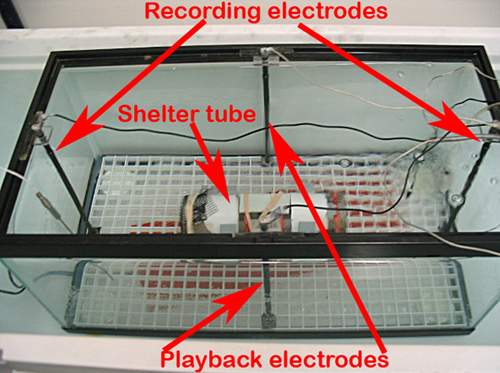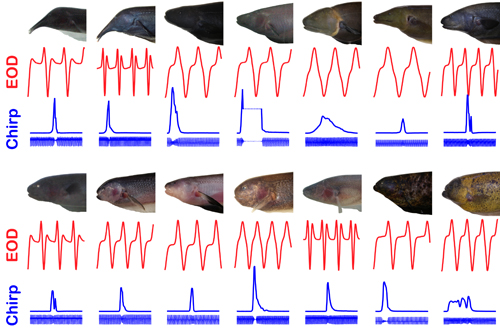Evolution of electrocommunication signals
Our laboratory studies two different types of communication signals in electric fish: the electric organ discharge (EOD), and modulations of the EOD known as chirps (click here for background information on chirping).
We study EODs and chirping in different species of ghost knifefishes (Apteronotidae), the largest family of South American electric fishes. EOD frequency ranges from ~500 Hz to 2000 Hz in these fish (click here for background information on species differences in EOD frequency). The waveform of the EOD (how the voltage changes during a single discharge) also varies across species. Species differences in EOD frequency and waveform may allow fish to use the EOD to identify the species of other fish.
Although EOD frequency and waveform have been studied in many species of electric fish, relatively little is known about how chirping varies across species. Because chirps are produced when fish encounter rivals or potential mates, they are likely to be important social signals. We study both inter- and intra-specific diversity in the structure and function of chirps to understand how these communication signals evolve.
To study the structure of chirps, we use a "chirp chamber" to present fish with electrical playbacks that simulate the presence of another fish. Because EOD frequency differs between species and between the sexes, we can manipulate the frequency of the playback stimulus to simulate the presence of a fish of the same sex or opposite sex in the chirp chamber. Fish respond robustly to playback stimuli, in some cases producing hundreds of chirps during a two-minute playback trial. We record the fishes' EODs with an amplifier and a computer and then use customized software to count and measure the chirps. The electrical signal has been converted into sound. The first sound you will hear is the subject's own EOD. After a few seconds, the playback stimulus is presented (audible as a second tone), and the fish chirps in response to the playback.
Typical Playback Experiment
 |
Chirp chamber. Fish are housed in a shelter tube (similar to tubes used by fish for shelter in their home tanks) secured to the bottom of a tank, and their EODs are recorded with electrodes located at each end of the tank. Electrical stimuli simulating the EODs of other fish are played back to subjects through electrode located on the sides of the tank. |
Chirping has been most extensively studied in brown ghost knifefish (Apteronotus leptorhynchus). Brown ghosts produce high-frequency chirps, which may function as courtship signals, and low-frequency chirps, which may function as aggressive signals. The closely-related black ghost knifefish (A. albifrons) also produces high- and low-frequency chirps, but chirps in black ghosts last many times longer than those in brown ghosts. Furthermore, work in our laboratory (Kolodziejski et al. 2007) suggests that high- and low-frequency chirps have evolved different functions in brown ghosts and black ghosts (click here to learn more about our research on the functions of EODs and chirping).
The structure of chirps varies across species of ghost knifefish. For example, the marble leaf knifefish (Adontosternarchus devenanzii), unlike brown ghosts and black ghosts, produces high-frequency chirps, but not low-frequency chirps. Furthermore, some of the chirps in A. devenanzii have complex structures with multiple frequency peaks.
 |
| EODs and chirps of 14 different species of ghost knifefish, most of which were collected from the Brazilian or Peruvian Amazon. Red traces show the head-tail voltage of the EOD, and illustrate species differences in EOD frequency and waveform. Blue traces show EOD frequency (top) and voltage(bottom) during species-typical chirps. Based on Turner, et al. (2007). |
